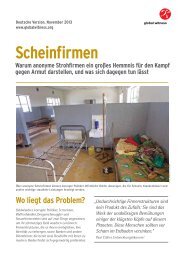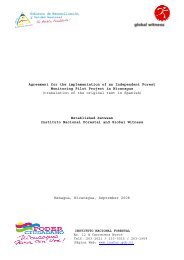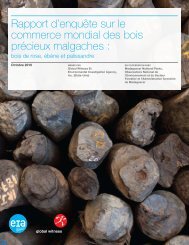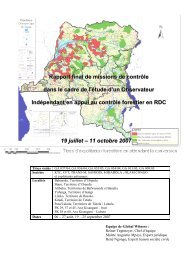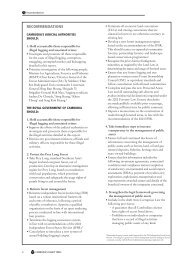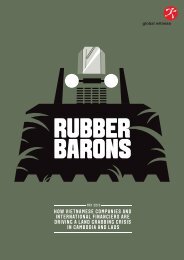03sep3 Conflict of Interests 60-89.pdf - Global Witness
03sep3 Conflict of Interests 60-89.pdf - Global Witness
03sep3 Conflict of Interests 60-89.pdf - Global Witness
You also want an ePaper? Increase the reach of your titles
YUMPU automatically turns print PDFs into web optimized ePapers that Google loves.
Part Two: Logging in Burma / 19 The China-Burma Border<br />
19.5.2.5 Guyong<br />
Guyong town is situated at the junction <strong>of</strong> the<br />
Tengchong to Houqiao road and the road to Tze Tze in<br />
Baoshan Prefecture. The town has been involved in<br />
logging, as a log storage area, since 1994 and as a<br />
processing centre since 1997. In 2001 there were<br />
approximately 100 sawmills in the town, including<br />
those in Minguan Township. 327 Most <strong>of</strong> the factories are<br />
very small and relatively crude.<br />
Making wood flooring in a small workshop in Guyong.<br />
19.5.3 Dehong Dai Jingpo Autonomous Prefecture<br />
In late 2000 the <strong>of</strong>ficial cost <strong>of</strong> teak was at least $800 per<br />
m 3 , whereas the Chinese could get it, all costs included,<br />
for 3,000 yuan ($361) per m 3 and sell the timber for<br />
5000 yuan ($<strong>60</strong>2) per m 3 in China, according to one<br />
Sino-Burmese businessman interviewed by <strong>Global</strong><br />
<strong>Witness</strong>. This represents an instant tax-free pr<strong>of</strong>it <strong>of</strong><br />
almost $250 for every cubic metre imported to China.<br />
According to the same source the Burmese Forest<br />
Department was very concerned because in places such<br />
as Hong Kong, Vietnam and Malaysia, Burmese timber<br />
could be bought at lower prices than in Rangoon,<br />
because <strong>of</strong> the illegal timber traffic across the Chinese<br />
border. 337<br />
The main destination for the timber was China’s<br />
domestic market, with wood being transported from<br />
the border to cities such as Kun Ming, Guang Zhou,<br />
and Shang Hai. Some <strong>of</strong> the timber was destined for<br />
export; planks to Japan and flooring to Italy being<br />
mentioned by a number <strong>of</strong> businessmen. 337<br />
89<br />
A CONFLICT OF INTERESTS<br />
19.5.3.1 Ruili<br />
The economies <strong>of</strong> Ruili and Wanding boomed<br />
immediately after the 1988 border trade agreements<br />
between Burma and China. Until then, insurgent<br />
groups controlled the border and Ruili was a supply<br />
centre for Chinese aid to the Communist Party <strong>of</strong><br />
Burma (CPB). After 1988 natural resources poured out<br />
<strong>of</strong> Burma whilst cheap Chinese goods poured in. Ruili<br />
and nearby Wanding were also key border ports for the<br />
export <strong>of</strong> timber.<br />
In 1993 one observer remarked that between 1,500<br />
and 3,750 tonnes <strong>of</strong> wood, mostly teak, left Burma via<br />
Wanding six days in every week. “It is possible to make a<br />
conservative estimate that at least 300 five-tonne trucks,<br />
and as many as 750, return across the border from Burma<br />
and back into China every working day and at least half<br />
<strong>of</strong> these, including covered trucks, carry mostly short cut<br />
logs, some milled timber and even parquet flooring.” 338<br />
Observers in 2000 also reported significant<br />
movements <strong>of</strong> log trucks; one account mentioned<br />
upwards <strong>of</strong> 70 log trucks coming across the border near<br />
Ruili each day. 339 Although in April 2001 relatively few<br />
log trucks were seen coming from Burma those that<br />
were seen were carry cargoes <strong>of</strong> teak and were larger<br />
than the regular Chinese five tonne trucks, that<br />
otherwise dominate the cross border logging trade. This<br />
suggests that these were <strong>of</strong>ficial transports between<br />
Burma and China. 327<br />
A businessman interviewed in Ruili told <strong>Global</strong><br />
<strong>Witness</strong> that there had been a serious decline in the<br />
timber trade since about 1998; there were once 100<br />
timber companies operating in the area but by early<br />
2001 only ten companies were left. The same person<br />
said that the crushing <strong>of</strong> the Mongkoe Defence Army<br />
in late 2000 had had a significant impact on the trade.<br />
According to the businessman, the Burmese<br />
government was firmly in control <strong>of</strong> the other side <strong>of</strong><br />
the border. Chinese companies had been told by the<br />
Tatmadaw to leave the forests in Burma and anyone<br />
cutting hardwood trees would be shot. 337<br />
One company visited by <strong>Global</strong> <strong>Witness</strong> that had<br />
fixed assets in Ruili and could not therefore leave easily<br />
needed to get their timber from Meng’a further south<br />
along the border, adjacent to Wa-controlled areas.<br />
However, in comparison to the level <strong>of</strong> the logging<br />
trade adjacent to Kachin State, this was very small.<br />
<strong>Global</strong> <strong>Witness</strong> was also told that in November 2000<br />
the SPDC had given orders that all logging and the<br />
smuggling <strong>of</strong> timber across the borders in northern<br />
Shan State, opposite Dehong Prefecture, was illegal,<br />
and that loggers were increasingly moving north, to<br />
areas fed by Kachin State, such as Pian Ma (see page 85)<br />
and Tengchong.<br />
19.5.3.2 Yingjian<br />
There are between 50 and 70 sawmills in Yingjian Town<br />
that are supplied by at least four feeder towns: Hong<br />
Bom He, Laozhaizi, Xima and Carzan. 327 The timber




